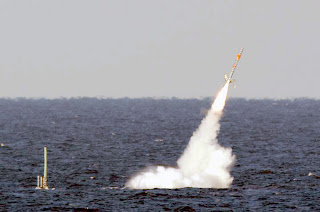Navy belatedly recognizing China missile threat
Back in the 1980's, the US Navy began deploying its enormously expensive and hi-tech Aegis weapons system to combat the threat from low observable cruise missiles. Like the British Royal Navy once felt with its ASDIC (Sonar) as a total answer to the submarine menace before the world war, the Admirals seem to consider the missile problem solved. However the Aegis system has yet to be completely tested under full combat conditions and some contend, including yours truly, that more radical hull designs are required to ensure our fleet survives the next "Armageddon at Sea". Here's more from Defense Daily (sorry, subscription only):
If the United States were to procure Littoral Combat Ships
(LCS), the DDG-1000 destroyer, and other stealthy, radar-evading platforms, it
would help U.S. forces to overcome the threat of Chinese missiles aimed at the
Taiwan Strait, a top admiral said yesterday. Adm. Tim Keating, commander of the
U.S. Pacific Command, described conversations he had with Chinese military and
other leaders during his recent trip to China, in which Keating sought, but
didn't receive, a full and open transparent explanation of why China has
embarked upon a lavish military buildup, including "a bristling number of
surface missiles directed across the Strait of Taiwan." Chinese leaders only
offered a general response, saying that the missiles are to "protect the things
that are ours," Keating told the Defense Writers Group. China has 1,328
radar-guided missiles aimed at the waters between Mainland China and Taiwan,
according to a Taiwanese estimate.
Some military analysts said that deadly concentration of
missiles means that the U.S. Navy cannot risk sending the current generation of
non-stealthy aircraft carriers, Ticonderoga-class cruisers, Arleigh Burke-class
destroyers and other non-radar-evading ships into the strait if China attempts
to invade Taiwan...analysts say if non-stealthy U.S. ships are sent into the
strait, all those Chinese missiles could sink the American vessels.

This latter problem is something which concerns me greatly, that we are attempting to fight a new war involving astonishingly accurate precision guided weapons, with the weapons of another era. Yet, the following comment by Keating makes me think the Navy will not go all the way:
"It is of less concern to us at the Pacific Command what particular
piece of hardware do we employ" in a shooting war, but rather how the "full
component, the full suite of systems, and systems of systems...ensures that the
first shot is not fired," he explained.
This makes me think the Navy is considering the deterrence is actually more crucial than preparing its forces to fight such a war. The new Maritime Strategy seems to lay greater importance on war prevention than war fighting as well. This, I think, is a major blunder which the US Army has had to learn the hard way in Iraq.
Winston Churchill once stated that "armies are meant to fight". The same goes for navies as well. If the Admirals must put all our precious fighting power into one costly basket (currently our aircraft carrier battlegroups), why not make it the most survivable and deadliest of our sea-going armada, namely stealthy attack submarines? Such mighty undersea vessels are already low (or no) observables, totally invulnerable to the cruise missile threat from China, and likely as much a counter to the Red Surface Navy as their subs our to our own.


